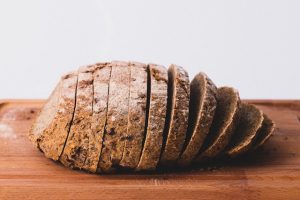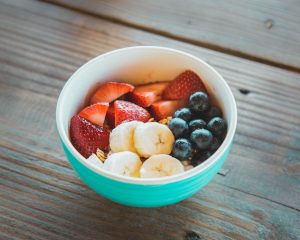Dietary fibre does wonders for your body. If I’d have to recommend one thing to get healthier, it would be to eat enough dietary fibre every day. And that’s a lot easier than you think. Eating enough dietary fibre, will leave you satiated longer so you are less likely to go all out on unhealthy snacks. Fibre also reduces the risk of cardiovascular diseases such as high cholesterol and type 2 diabetes. Besides this, it also helps with constipation and symptoms of irritable bowel syndrome. Moreover, they are simply delicious! Below I explain how you can incorporate more fibre into your diet.
What is dietary fibre?
Dietary fiber is the name for a group of carbohydrates that are not digested or absorbed by the small intestine. Fibres come from the cell walls of plants. So they are found in vegetables, fruit, legumes, potatoes, nuts and wholegrain products.
Soluble and insoluble fibres
There are different types of fibre, such as soluble and insoluble fibre. Soluble fibre keeps the stool in your intestines soft. It ensures good flow and good bowel movements. You can find soluble fibre in vegetables, fruit, potatoes, legumes, oats, barley, soybeans and seaweed.
Insoluble fibres absorb moisture. This increases the volume and allows the stool to be pushed out. You can find insoluble fibre in grain products, vegetables and especially in bran, wheat flour, peas, beans and cabbage.
Products high in fibre can reduce the risk of cardiovascular disease. This effect is greatest if you eat more than 25 grams of fibre each day.

How do you know if you are eating enough dietary fiber?
The recommended daily allowance (RDA) for fibre is 30-40 grams (this is RDA for the Netherlands, it may be different in your country). The label on the product states how much fibre is in the product (except for fresh fruit and vegetables). You can find this number in the nutritional table on the packaging.
For example, a slice of wholegrain bread contains 2.3 grams of fibre. Not exactly a very high number, you might think. Still, this is quite significant if you add up all the fibres you consume per day. If you would like to know whether you are getting those 30-40 grams of the daily recommendation, use a nutritional app to keep track of this.
How to get to 30-40 grams of dietary fibre every day?
30 grams of fibre may sound like a lot, especially when one slice of wholegrain bread contains ‘only’ 2.3 grams of fibre (for comparison: a slice of brown bread contains 1.8 grams of fiber and a slice of white bread 0.8 grams).
However, bread goes a long way, with four slices of wholegrain bread per day you are already at 9.2 grams. That’s almost a third of the minimum recommended amount. If you can, choose the wholegrain variant most of the times. The whole grain is processed here, including the fibres of the core of the grain (in white bread, this is filtered out, which is why there’s hardly any fibre in there).
Dietary fibre in white bread and wholegrain bread
You may now be thinking: “I like white bread much better, so I’ll just eat more of it and get the same amount of fibre!” Sounds quite clever and delicious, if you ask me. But you can hear the but coming 😉. Wholegrain bread uses the entire grain, so it contains more fibre, and therefore also more vitamins and minerals, than white bread. Logically, you’d get less fibre and micronutrients in your system if you always choose white bread.
Try to alternate bread with, for example, wholegrain crackers, wholegrain breakfast cereals. This is how you keep it tasty.

Fibre fact: grain fibre has special powers
The anti-inflammatory effect of fibre is said to reduce the risk of cardiovascular disease. However, in a new study from Columbia University, researchers show that this is only due to grain fibre, and not from fibre from vegetables or fruit.
And this beneficial effect may not only be due to the grain fibre itself, but also to other nutrients in grains. To be on the safe side, choose wholegrain and you’ll be fine! Source: News for dietitians.
Vegetables, fruit, nuts and beans
In addition to bread, it is important to eat other products with dietary fibre: vegetables, fruit, legumes, nuts and wholegrain products such as brown rice and whole wheat pasta.
What do your meals actually look like if you want to eat enough dietary fibre?
Use these tips for your own meals:
- Eat a piece of fruit twice a day, preferably with the peel, as that contains a lot of fibre.
- Try to eat a lot of vegetables every day, preferably 250 grams per day. That sounds like a lot and it is. Yet it has many benefits: it keeps your weight under control, you can reduce health problems, and it is simply very tasty! Read practical tips below for eating more vegetables.
- Take legumes every day, such as beans, lentils and chickpeas: add them to your meal or just eat as a snack (such as a bowl of chickpeas, you can heat them up in the oven for 10 minutes to make them more crispy, add paprika powder before you put them in).

- Choose the wholegrain variant of bread, pasta, rice and couscous. Different brands have different tastes. If you’re not really into hardcore wholegrain rice, try mixing it with white rice first and add less and less white rice over a period of time. After a few weeks, your taste will have changed, and you may like the whole wheat variant more and you don’t want anything else!
- Are you not sure whether a product contains enough fibre? Check the amount of fibre in the nutritional table on the packaging and compare it with other products. Choose the one with the most fibre.
- What do the claims “rich in fibre” and “source of fibre” mean? Sometimes products are labeled: “rich in fibre” and “source of fibre”. These are claims that are legally established in the Netherlands. If a product is high in fibre, it contains at least 6 grams of fibre per 100 grams. That’s a great choice. If it is a source of fibre, it contains 3 grams of fibre per 100 grams. Also a good choice.

Tips for eating more vegetables every day
- For lunch, have a salad with lettuce, snack tomatoes, cucumber, carrots, radishes and celery, with some hummus or cottage cheese.
- Make your sandwich more attractive by topping it with lettuce, tomato and cucumber.
- Have snack vegetables (small cucumbers, small tomatoes, carrots) as a snack (with dip).
- Make sure that half of your plate consists of vegetables for the main meal. Serve it first, followed by potatoes/rice/pasta (a quarter of your plate) and meat (a quarter of your plate).
- Place the pan with vegetables on the table (and the carbohydrates in the kitchen), so you can easily take more.
Drink enough water to balance out the fibre
Eating enough dietary fibre is important. But drinking enough water may be even more essential. Fibres act like a sponge in your intestines: they attract moisture. This makes your stool soft and flexible. If there is insufficient fluid available, the stool becomes hard and you may suffer from constipation. So try to drink about 1.5-2 liters of water every day (tea, coffee or milk counts as well). Preferably even more, e.g. up to 2.5 liters per day.
Don’t ‘drink’ your food
It is better not to drink your food (ha, that sounds weird), such as in a smoothie. This contains much less fiber than if you eat the fruit or vegetables you put in it separately. An occasional smoothie is fine (especially if it replaces an unhealthy snack), but make sure you basically eat enough fruit and vegetables. If you already do that, there’s no harm in a smoothie every day. Enjoy!

Checklist to incorporate fiber into your diet
- Choose whole wheat or fiber-rich products: wholegrain bread, crackers or breakfast cereals, whole wheat pasta, brown rice, etc.
- Eat 250 grams of vegetables and 2 pieces of fruit (with peel) per day
- Eat 30-40 grams of fiber per day, e.g. choose from:
- 1 slice of whole wheat bread: 2.3 grams of fibre (white bread: 0.8 grams of fiber)
- 1 banana: 2.5 grams of fibre
- 1 apple with peel: 2.7 grams of fibre
- 1 serving spoon (60 grams) of chickpeas: 4.3 grams of fibre
- 1 handful of unsalted almonds: 1.8 grams of fibre
- 1 bowl of raw vegetables: 0.8 grams of fibre
- 10 snack tomatoes: 1 gram of fibre
- 2 carrots (40 grams): 1 gram of fibre
- Drink at least 1.5-2 liters of fluid per day so that fibers can do their job properly. Water, milk, tea and coffee without sugar count. For example:
- 10 glasses of water per day,
- or 3-4 cups of tea + 5 glasses of water,
- or 2 cups of tea + 2 cups of coffee + 5-6 glasses of water.
- or your own combination!
Takeaway
By eating enough fibre, you keep your body healthy. Eating 30 to 40 grams of fibre every day reduces the risk of all kinds of diseases and ensures that you can keep your weight under control. If you eat fibre with every meal, it should not be a problem to meet your daily requirements. Don’t forget to drink 1.5-2 liters, for example water, tea, coffee and (butter)milk. This keeps your bowel movements going and your stools soft.
Getting enough fibre in your daily pattern can be challenging. A while ago I wrote a blog that can help you make this into a new habit. I hope this helps!
Best wishes,
Femke

